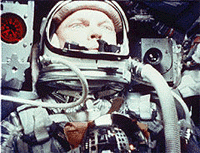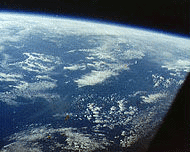
 |
| Glenn onboard Friendship 7 during America's first orbital flight. (NASA) |
 |
| A view of Earth taken from Friendship 7 (NASA) |
Orbiting the Earth
From 100 miles above Earth, Glenn spots a dust storm in Nigeria and lightning flashes over the Indian Ocean. At sunrise Glenn sees little specks, brilliant specks, floating around outside the capsule. These "fireflies" are later found to be paint flecks and ice from his capsule.Suddenly, one of the craft's jets quits working. Like a car with a flat tire, the ship keeps sliding to the right. Glenn has to fly manually to stay on course.
Then, Mission Control receives data showing that the capsule's heat shield is loose. If it falls off, Glenn will burn up when he tries to return to Earth. Mission Control decides not to tell him about the problem.
Friendship 7 has a retro-pack of three small rockets. These are designed to slow the ship down during re-entry, then fall away. The heat shield is underneath them. Just before Glenn fires the rockets, Mission Control says to keep the retro-pack connected to the ship. They hope the straps will hold the heat shield in place. Glenn now knows that his heat shield might fail.



